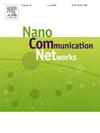Microfluidic Pulse Shaping Methods for Molecular Communications
IF 4.7
4区 计算机科学
Q2 ENGINEERING, ELECTRICAL & ELECTRONIC
引用次数: 2
Abstract
Molecular Communication (MC) is a bio-inspired communication modality that utilizes chemical signals in the form of molecules to exchange information between spatially separated entities. Pulse shaping is an important process in all communication systems, as it modifies the waveform of transmitted signals to match the characteristics of the communication channel for reliable and high-speed information transfer. In MC systems, the unconventional architectures of components, such as transmitters and receivers, and the complex, nonlinear, and time-varying nature of MC channels make pulse shaping even more important. While several pulse shaping methods have been theoretically proposed for MC, their practicality and performance are still uncertain. Moreover, the majority of recently proposed experimental MC testbeds that rely on microfluidics technology lack the incorporation of programmable pulse shaping methods, which hinders the accurate evaluation of MC techniques in practical settings. To address the challenges associated with pulse shaping in microfluidic MC systems, we provide a comprehensive overview of practical microfluidic chemical waveform generation techniques that have been experimentally validated and whose architectures can inform the design of pulse shaping methods for microfluidic MC systems and testbeds. These techniques include those based on hydrodynamic and acoustofluidic force fields, as well as electrochemical reactions. We also discuss the fundamental working mechanisms and system architectures of these techniques, and compare their performances in terms of spatiotemporal resolution, selectivity, system complexity, and other performance metrics relevant to MC applications, as well as their feasibility for practical MC applications.分子通信的微流控脉冲整形方法
分子通信(Molecular Communication, MC)是一种利用分子形式的化学信号在空间分离的实体之间进行信息交换的仿生通信方式。脉冲整形是所有通信系统中的一个重要过程,它修改传输信号的波形,使其与通信信道的特性相匹配,从而实现可靠、高速的信息传输。在MC系统中,发射器和接收器等组件的非常规架构以及MC信道的复杂性、非线性和时变特性使得脉冲整形变得更加重要。虽然理论上已经提出了几种用于MC的脉冲整形方法,但其实用性和性能仍然不确定。此外,最近提出的大多数基于微流体技术的实验MC测试平台缺乏可编程脉冲整形方法的结合,这阻碍了在实际环境中对MC技术的准确评估。为了解决微流控MC系统中与脉冲整形相关的挑战,我们全面概述了已经经过实验验证的实用微流控化学波形生成技术,其架构可以为微流控MC系统和试验台的脉冲整形方法设计提供信息。这些技术包括基于流体动力学和声流场的技术,以及电化学反应的技术。我们还讨论了这些技术的基本工作机制和系统架构,并比较了它们在时空分辨率、选择性、系统复杂性和其他与MC应用相关的性能指标方面的性能,以及它们在实际MC应用中的可行性。
本文章由计算机程序翻译,如有差异,请以英文原文为准。
求助全文
约1分钟内获得全文
求助全文
来源期刊

Nano Communication Networks
Mathematics-Applied Mathematics
CiteScore
6.00
自引率
6.90%
发文量
14
期刊介绍:
The Nano Communication Networks Journal is an international, archival and multi-disciplinary journal providing a publication vehicle for complete coverage of all topics of interest to those involved in all aspects of nanoscale communication and networking. Theoretical research contributions presenting new techniques, concepts or analyses; applied contributions reporting on experiences and experiments; and tutorial and survey manuscripts are published.
Nano Communication Networks is a part of the COMNET (Computer Networks) family of journals within Elsevier. The family of journals covers all aspects of networking except nanonetworking, which is the scope of this journal.
 求助内容:
求助内容: 应助结果提醒方式:
应助结果提醒方式:


